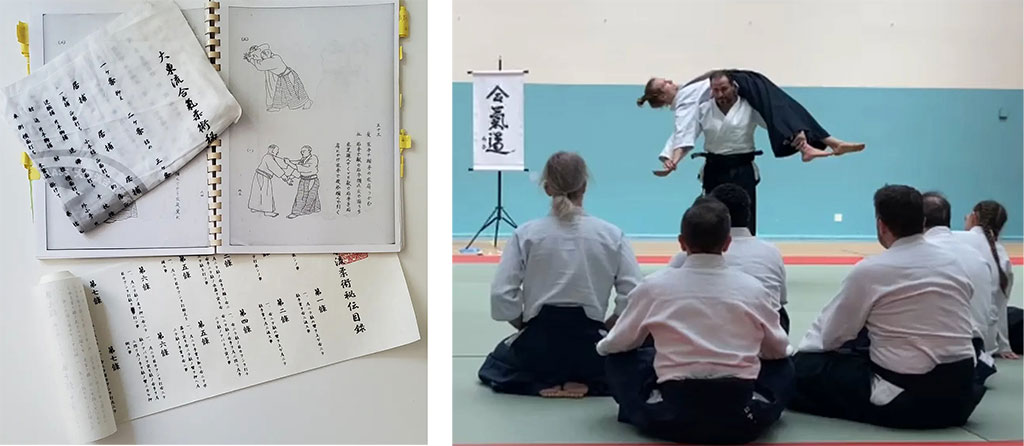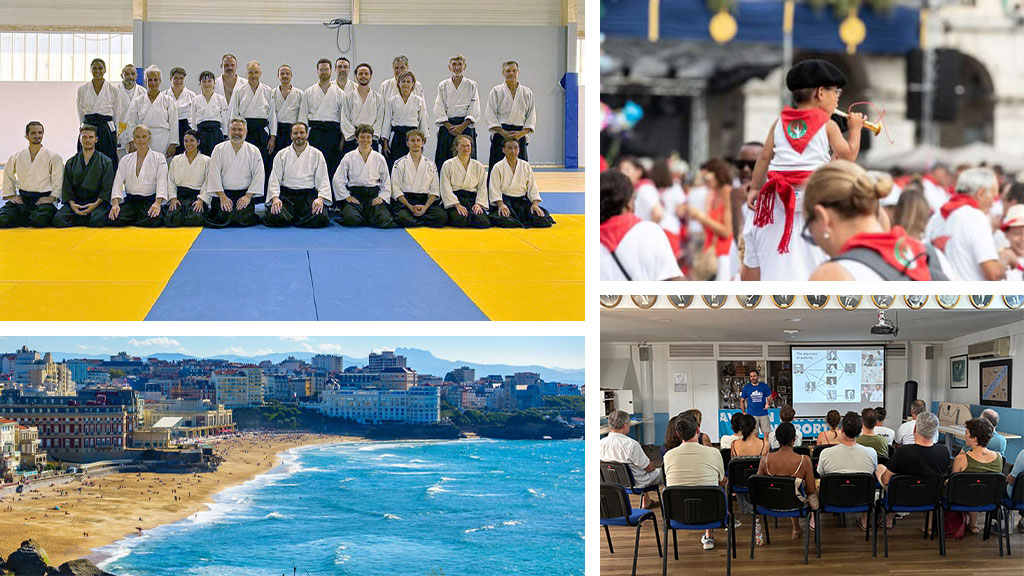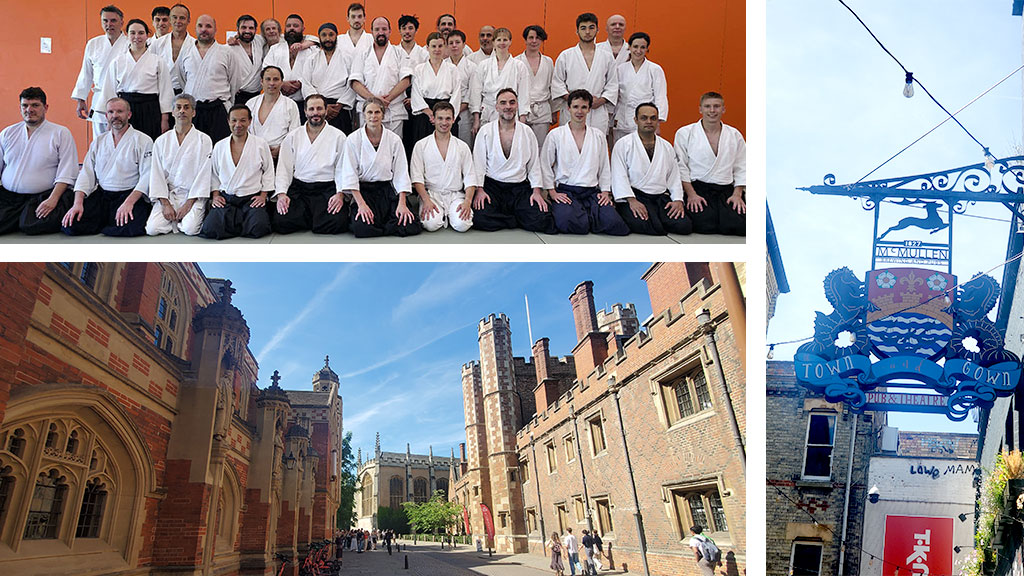This summer, Guillaume Erard Shihan—6th Dan Aikikai and esteemed instructor of both Aikido and Daito-ryu Aiki-jujutsu—led a remarkable series of seminars across Europe, visiting Emmendingen, Bayonne, Paris, and Cambridge. Central to this tour was a deep exploration of the root techniques preserved in the secret transmission scrolls (densho) and their evolution from the late 19th century to modern practice.
By studying these classical forms, many of which are little emphasized in contemporary Daito-ryu schools following Takeda Tokimune’s curriculum, Erard provided practitioners—especially Aikido students—with fresh perspectives on the technical and philosophical continuity underlying different styles. The seminars bridged tradition and modern biomechanics, encouraging tolerance, curiosity, and a richer understanding of Aikido’s living heritage.
A Central Theme: Roots and Relevance
The 2025 seminar series was unified by a rich thematic focus: the study of root techniques common to both Aikido and Daito-ryu Aiki-jujutsu, as documented in the secret transmission scrolls (densho), in particular the hiden mokuroku, which Erard Shihan brought with him to show the trainees, and to refer to throughout his tour. The document in particularly relevant due to the fact that many of the techniques that it describes often predate, or exist outside, the formalized pedagogical frameworks commonly seen in modern curricula.
Significantly, some of these techniques are rarely emphasized even in contemporary Daito-ryu practice, especially in branches that follow the curriculum systematized by Takeda Tokimune, the son of Takeda Sokaku. Erard’s exploration of these lesser-studied movements invites a reexamination of their practical and historical importance.

To provide context and historical depth, Erard offered lectures at each seminar location that introduced the structure and significance of the densho, as well as the origins of the techniques that would later be systematized in Aikido. These presentations helped frame the physical practice in terms of lineage and evolution, offering students a clearer picture of how Aikido’s technical DNA connects to its Daito-ryu roots.
This approach holds particular relevance for Aikido practitioners, as this scroll-based material represents much of what Ueshiba Morihei studied directly under Takeda Sokaku. In fact, in several respects, the organization of the Aikido curriculum aligns more closely with Takeda Sokaku’s original teaching methods than many modern Daito-ryu schools do. By revisiting these root techniques and their underlying principles, Erard offers Aikido students a unique window into the foundational lineage of their art.
Throughout the seminars, Erard connected these classical forms to fundamental concepts of body mechanics—internal structure, center stability, and efficient energy transfer—framing them within a modern somatic perspective that bridges tradition with contemporary movement science.
Emmendingen, Germany (June 20–22)
The tour began in Emmendingen, where local hosts welcomed participants to the Carl Helbing School for a packed three-day event. Each day started with weapons training (jo and bokken), followed by intensive sessions focused on taijutsu and internal work.
A highlight was the Saturday lecture on the origins of Aikido and the structure of the Daito-ryu scrolls, where Erard contextualized the techniques practiced on the tatami. These sessions added depth to the physical training and sparked lively discussions among attendees. The projector having been setup besides the mat, the group was able to go back and forth between explanations and technical applications in motion. This unusual format seems to have been particularly appreciated.

Bayonne, France (June 27–29)
In Bayonne—a region where Erard has taught regularly over the past ten years—the seminar continued its thematic exploration. The focus on classical technique and structural refinement created a deepened atmosphere of study, encouraging participants to engage with both the forms and their functional applications. A lecture session on technical genealogy and transmission models complemented the practical work.

Paris, France (July 5)
The one-day intensive in Paris took place in the legendary Stade Pierre de Courbetin, whom martial artists will know for being the father of modern Olympics, but also for being a friend of Kano Jigoro Sensei, the founder of Judo. Erard distilled key elements from the densho into two focused sessions, one in the morning, one in the afternoon. Despite its brevity, the seminar emphasized the same integration of traditional material with modern biomechanics, and began with a concise talk introducing the historical sources of key techniques.

Cambridge, UK (July 12–13)
The final stop brought Erard to Cambridge Aiki Dojo, where he further developed the themes of power generation, rooted movement, and spontaneous adaptation within the framework of the scroll-based curriculum. A well-attended lecture opened the seminar, drawing direct lines from the techniques of Takeda Sokaku to those of Ueshiba Morihei, illustrating both continuity and evolution.

Reflections
Guillaume Erard’s 2025 European seminar tour provided a rare, cohesive journey into the living tradition of Aikido and Daito-ryu, reconnecting practitioners to the original source material studied by Ueshiba Morihei himself.
By illuminating lesser-known techniques and linking them with modern biomechanical insights, Erard invited students to explore how the foundations of Aikido remain deeply intertwined with Takeda Sokaku’s teachings. The closer alignment of Aikido’s curriculum with Takeda’s original method—compared to much of modern Daito-ryu—makes this approach especially valuable for Aikido practitioners seeking a richer understanding of their art’s roots.
A particularly important point Erard highlighted was the value of studying the evolution of techniques like ikkyo over time—from the late 1800s to today. This diachronic perspective helps practitioners recognize that, despite apparent stylistic differences, there are more similarities between how various schools teach these techniques than differences. Such insight encourages a spirit of tolerance and curiosity towards other styles, fostering a more open and interconnected martial arts community.
? Want to Join Next Time?
For those who missed the 2025 tour, keep an eye on Guillaume Erard’s official website and social media for announcements. With annual European teaching trips becoming a tradition, another inspiring series is expected in 2026.





